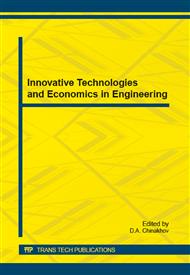[1]
S.I. Petrushin. Theoretical basis of optimization of the cutting heads of edge tools. Dissertation of the doctor of engineering sciences: 03. 05. 01. - Presented on July 01, 1998: Aff. on November 20, 1998 - Yurga: 1998. - 362 p.
Google Scholar
[2]
S.I. Petrushin. Designing of the cutting heads of tools made of composite materials. / СТИН. - 1997, - No. 2. - P. 26-29.
Google Scholar
[3]
A.S. Vereshchaka. Efficiency of the edge tools with wear-resistant surfaces. – Moscow: Mashinostroyenie, 1993. – 336 p.: fig.
Google Scholar
[4]
O.Y. Retyunsky. Method of making performs for composite reversible cutting plates / Applied Mechanics and Materials. - 2013 - Vol. 379. - pp.24-27.
DOI: 10.4028/www.scientific.net/amm.379.24
Google Scholar
[5]
A.V. Valentov, V.V. Konovodov, E.V. Agafonova. Forecasting residual and operating stress in soldering cutting tools with tungsten-free alloy inserts / Applied Mechanics and Materials. - 2013 - Vol. 379. - pp.28-31.
DOI: 10.4028/www.scientific.net/amm.379.28
Google Scholar
[6]
C.M.T. Law, C.M.L. Wu, D.Q. Yu, Microstructure, solderability, and growth of intermetallic compounds of Sn–Ag–Cu-Re leadfree solder alloys[J]. J. Elec. Materi. 35, 89–93 (2006).
DOI: 10.1007/s11664-006-0189-7
Google Scholar
[7]
A.I. Afonasof, A.A. Lasukov. Elementary chip formation in metal cutting /Russian Engineering research, 2014, Vol. 34, No. 3, hh. 152-155.
DOI: 10.3103/s1068798x14030034
Google Scholar
[8]
R.V. Chernukhin. Reliability of the steering gear of truck vehicles/ Applied Mechanics and Materials. - 2013 - Vol. 379. - pp.36-42.
DOI: 10.4028/www.scientific.net/amm.379.36
Google Scholar


